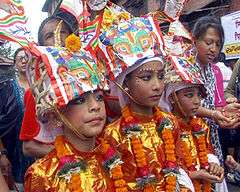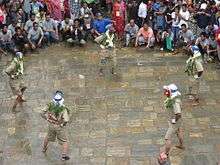Gai Jatra
Gai Jatra, (gāimeans cow and jātrā means festival in Nepali: गाई जात्रा, and Nepal Bhasa: सा पारु) is a festival celebrated in Nepal, mainly in Kathmandu valley by the Newar community.[1] The festival is generally celebrated in the month of Bhadra (August–September). The date is set according to the lunar Nepa and falls on the first day of the dark four night of the month of Gunla.
| Gai Jatra | |
|---|---|
 Decorations of Gaijatra | |
| Also called | Sa Parthfu |
| Observed by | Hindus |
| Type | Religious, Nepal |
| Observances | Ralley of Cow |
| Date | First day of Pratipada of the month of Bhadra month of the Lunar calendar |
| 2019 date | 16 August 2019 |
Gai Jatra in different cities
It is also celebrated in various places like Kathmandu, Patan, and Bhaktapur.
Kathmandu
Kathmandu is considered to be the main source of this festival as the king who started this festival was from this city. After the show presented to the queen was a success, it became an annual program to present the queen with this festival. As time passed on and as the kings and the queens passed on, the festival has been passed on from generation to generation. In main Kathmandu, people celebrate it with much happiness and many programs than those on Patan. The procession goes around the city to different parts of the suburbs and the inner urban areas to present the devotion to their loved ones. The people involved in this profession get small packets with fruits, sweets, oats and other food items to help them on their tour around the city, by many people watching the festival and by their loved ones.
Patan
Patan has a similar kind of following for this festival like that with Kathmandu, but has less involvement of people than that on Kathmandu. People in Lalitpur have another festival similar to Gaijatra called Matayaa which is followed by Hindu with much more devotion and much more involvement by the people. The involvements of people in this Matayaa can be in thousands. Thus, for people in Lalitpur, the procession of Gaijatra is less entertained.
Kirtipur
Gaijatra is celebrated widely in Kirtipur, particularly in Kirtipur's ancient historical towns Kipu dey: . The people in Kirtipur celebrating have many reasons to celebrate this festival and have a unique way of celebrating this festival. Among the people of Kirtipur, it is said that the gates of heaven for the dead are opened in this day, and the procession of Gaijatra will help their beloved to reach the gates of heaven if they march around the city for them. They march around the city of Kirtipur with not dressing up like cows but rather dressed up in different forms of gods and goddesses. People celebrate this festival not only for their dead relatives but also for peace and harmony among the family members and the city itself.

During this month the farmers of the city finish up their work in the fields and return home to celebrate the ending of the hard and tedious work in the fields. They gather the family members and have a feast of their success. This culture is replicated in this festival in Kirtipur. Men dress up like women and travel around the city. They go from house to house calling up the owners of the house and asking them to come down and join in the feast with them. This helps to create harmony among the neighbors and the city members. Kirtipur performs many dances with different imitating artists that provide much of an awe and a happiness among the people. Kirtipur is enriched with many beliefs and many stories relating Gaijatra than any other cities of the valley and has a more diverse celebration of this festival.
Bhaktapur
Bhaktapur is said to have the most enjoyable and exciting Gai Jatra, as it has its own peculiarities in the ways the festival is celebrated as compared to Lalitpur and Kathmandu. A chariot (known as Taha-Macha) made of bamboo wrapped in cloth, with a photo of the dead person hung at the center, is navigated through a predefined street by the family along with localities. So a long parade of chariots is seen.
The Taha-Macha symbolize dead people and is decorated with their possessions and photograph. The chariot has a framework of bamboo which is wrapped with cotton cloth usually Hakupatasi (a black traditional sari type female cloth) for women and simple sari type cloth for men. The Taha-Machas are brought out from different toles of Bhaktapur, but peculiarly, the Taha-Machas of Lakolachhen are guided by one large one that has the bamboo framework but is covered in straws. This is known as Bhailya Dya: (Bhairab) and is succeeded by Ajima (Bhadrakali) made at Khala (Ajima Dyo:Chhen)
Many local musicians, and a cultural dance called Ghintang Ghisi follow in the wake of a chariot.. Men are also seen wearing women's dress: Hakupatasi. People dress up funnily. There is face painting and masks are common. Children even dress up as Gods and join the parade.
The Ghintag Ghisi dance is celebrated for almost a week, starting from the day of Gaijatra to Krishna Janmashtami. The dance is done in a long queue with two persons in a row hitting each other's sticks. Many cultural shows are performed, and the festival is even participated in by many nearby villages. All peoples are faint to this day.
References
| Wikimedia Commons has media related to Gai Jatra Festival. |
- Archived 2008-05-09 at the Wayback Machine Nepal Home Page

